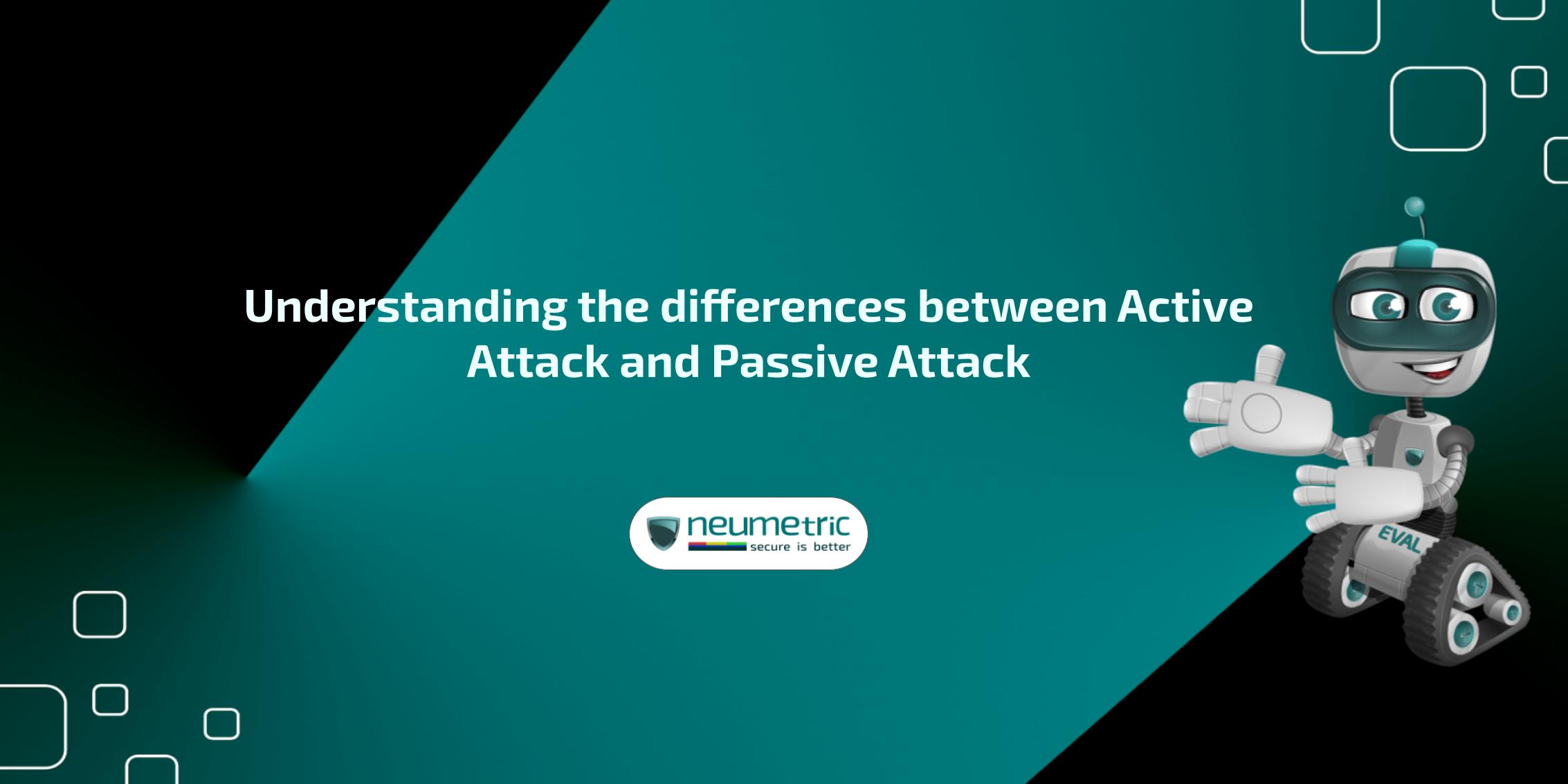Table of Contents
ToggleIntroduction:
In today’s interconnected world, where digital technologies support practically every aspect of society & industry, cybersecurity is a major worry. Our reliance on digital infrastructure increases, as does the sophistication & frequency of active attacks & passive attacks. Understanding the differences between active & passive attacks is critical for establishing successful protection measures in today’s ever-changing threat environment.
Cybersecurity is now connected with the digital age’s survival & success. Organizations rely on strong cybersecurity safeguards to secure sensitive data, ensure operational continuity & preserve consumer trust. Cybersecurity breaches have serious implications, ranging from financial losses & legal responsibilities to reputational damage & a loss of competitive advantage. Furthermore, as digital transformation accelerates across businesses, cybercriminals’ attack surface grows, needing ongoing awareness & adaptation to cybersecurity procedures.
This journal will get deeper into the distinctions between active & passive cyber attacks, examining their technical foundations, real-world instances, security tactics & broader consequences. Following this introduction, the journal will conduct a thorough assessment of each assault type, highlighting their distinct characteristics, tactics & consequences. It will then go into the technological methods & tools available for detecting & mitigating these attacks, followed by an examination of the behavioral & social engineering factors that contribute to their effectiveness. Furthermore, the paper will look at the legal & ethical issues surrounding cyber attacks, providing insights into the changing environment of cybersecurity rules & ethical quandaries confronting both defenders & attackers alike.
Passive Attacks: Overview & Examples
Passive attacks are distinguished by their covertness. The fundamental goal of a passive assault is to monitor & collect information without modifying the data or disturbing the communication process. Passive attacks are especially difficult to detect because of their covert nature & they can persist for long periods of time, quietly siphoning off valuable information.
Eavesdropping: Eavesdropping is one of the most popular types of passive attacks. Eavesdropping involves intercepting & listening to private communications. This can occur through a variety of methods, including phone lines, internet connections & wireless communications. The intercepted data may include sensitive information such as credit card numbers, passwords or confidential company information.
Traffic Analysis: Even if the data is encrypted & thus inaccessible, attackers might exploit traffic patterns to derive useful information. For example, by evaluating the frequency, size & timing of data packets, attackers can determine the nature of the connection, identify the parties involved & possibly discover the communication protocol being used.
Passive Reconnaissance: Before launching an active attack, attackers frequently do passive reconnaissance to learn about their target. This may entail monitoring social media, public data & other Open-Source Intelligence [OSINT] to develop an understanding of the target’s network infrastructure, security measures & potential vulnerabilities.
Passive attacks can have a major impact, especially when the information acquired is sensitive. For example, intercepted emails containing corporate strategy or personal information can result in competitive disadvantage, identity theft or other forms of abuse. However, because passive assaults do not alter data or interrupt services, they frequently go undetected until the stolen information is utilized maliciously.
Active Attacks: Overview & Examples
In contrast to passive assaults, active attacks require direct engagement with the target system & frequently result in data change, service disruption or unauthorized access. Active attacks are more aggressive, making them easier to detect. They can have an immediate & noticeable influence on the Confidentiality, Integrity & Availability [CIA] of information systems.
Man-in-the-Middle [MitM] Attacks: In a MitM attack, the attacker intercepts & may change communication between two parties without their knowledge. This allows the attacker to read, insert & alter messages sent between the conversing parties. Such attacks can result in serious breaches of confidentiality & data integrity.
Denial-of-Service [DoS] Attacks: A DoS attack aims to overwhelm a system’s resources to the point where it is unable to offer the desired services. This can include flooding a network with too much traffic or delivering faulty packets that cause the system to fail. DoS assaults can disrupt business operations, causing financial losses & reputational damage.
Spoofing: Spoofing attacks include the attacker impersonating another device or user in order to gain unauthorized access to systems or data. IP spoofing, for example, is the practice of sending communications to a computer with a falsified IP address in order to make the message appear to be from a trusted source. This allows attackers to get around security safeguards & obtain critical information.
Replay Attacks: Replay attacks occur when an attacker intercepts a lawful data transmission & retransmits it at a later time. This is especially dangerous in systems that rely on time-sensitive transactions or One-Time Passwords [OTPs]. By replaying these messages, attackers can acquire unauthorized access or modify transaction results.
Active attacks frequently have quick & disruptive consequences. For example, a successful ransomware attack can halt a business by encrypting essential data & demanding a fee to decrypt it. Similarly, a denial-of-service assault can disrupt internet services, resulting in considerable financial losses & customer unhappiness.
Technical Mechanisms & Tools for Defense
In the ever-changing cybersecurity landscape, protecting against passive & active threats necessitates a combination of technical procedures & techniques. Effective defense systems must account for the distinct characteristics & hazards provided by each type of attack. This section investigates the many technical methods & technologies that can be used to safeguard information systems from both passive & active threats.
Defense Mechanisms Against Passive Attacks
Encryption:
- Data Encryption: Encrypting data at rest & in transit is an important barrier against passive attacks. By converting readable data into an unreadable format using cryptographic algorithms, encryption ensures that intercepted data is unavailable to unauthorized parties. Common encryption technologies include Advanced Encryption Standard [AES] for data encryption & Transport Layer Security [TLS] for secure network connection.
- End-to-End Encryption: This ensures that data is encrypted on the sender’s end & decrypted only on the recipient’s end, allowing for a secure communication channel even via potentially hacked networks.
Secure Communication Protocols:
- TLS/SSL: TLS/SSL are cryptographic technologies that enable secure communication over a computer network. They are commonly used to secure web traffic, email & other types of data transmissions.
- IPsec: Internet Protocol Security [IPsec] is an array of protocols for authenticating and encrypting IP packets in an exchange of data sessions. It is commonly used to construct Virtual Private Networks [VPNs].
Network Security Monitoring:
- Intrusion Detection Systems [IDS]: IDS scan network traffic for unusual activity & known threats. By monitoring traffic patterns, IDS can detect potential eavesdropping or traffic analysis attempts. IDS can be set to notify administrators when unexpected behavior is noticed.
- Network Traffic Analysis Tools: Wireshark & Zeek (previously Bro) are network traffic analysis tools that may detect anomalies that may suggest passive reconnaissance or data interception.
Defense Mechanisms Against Active Attacks
Intrusion Prevention Systems [IPS]:
- Signature-Based IPS: These systems use known attack signatures to detect & prevent harmful activity in real time. They are effective against known threats, but require regular upgrades to remain so.
- Behavioral-Based IPS: These systems examine network traffic & system operations to detect irregularities that could signal an attack. They can detect zero-day attacks by observing abnormalities from regular behavior.
Firewalls:
- Network firewalls: These devices monitor & manage incoming & outgoing network traffic using predefined security rules. Firewalls can prevent unwanted access, filter communications & stop certain forms of active attacks.
- Web Application Firewalls: Web Application Firewalls [WAF] protect web applications by screening & monitoring HTTP requests. They can stop SQL injection, Cross-Site Scripting [XSS] & other web-based assaults.
Endpoint Protection:
- Antivirus & anti-malware software: These programs scan for, detect & delete harmful software from endpoint devices. They can protect against malware infections that could be exploited to launch active attacks.
- Endpoint Detection & Response [EDR]: EDR solutions enable continuous monitoring & response to endpoint devices. They can identify & react to threats like ransomware, phishing & Advanced Persistent Threats [APTs].
Behavioral Aspects of Cyber Attacks
Understanding the behavioral characteristics of cyber attacks is critical to building successful protection methods. These factors include the goals, strategies & psychological manipulation methods employed by attackers. By investigating these aspects, businesses can better predict, recognize & mitigate cyber threats. This section delves into the many behavioral aspects of cyber attacks, such as attacker motivations, social engineering techniques & attack patterns.
Financial gain
- Cybercrime: Many attackers are motivated by the prospect of financial gain. This includes ransomware assaults, in which attackers encrypt a victim’s files & demand payment for the decryption key, as well as phishing operations that attempt to obtain financial information such as credit card numbers & bank account information.
- Fraud: Attackers frequently engage in fraudulent actions, such as identity theft, which involves using stolen personal information to commit financial fraud. This may also include utilizing stolen credentials to make illicit purchases or take monies from bank accounts.
Political & Ideological Objectives
- Hacktivism: Hacktivism is driven by political or social causes. They utilize cyber attacks to forward political goals, disrupt opposing activity or raise awareness about specific topics. Website defacement, denial-of-service assaults & data leaks are all common strategies.
- State-Sponsored Attacks: Nation-states use cyber espionage & warfare to obtain strategic advantages. These attacks are intended to steal sensitive information, disrupt essential infrastructure or threaten political stability. State-sponsored attacks frequently target government entities, defense contractors & essential industries.
Revenge & Personal Vendettas
- Insider Threats: Disgruntled employees or former employees may initiate retaliatory attacks on their companies. These insiders frequently have intimate understanding of the organization’s systems & can inflict severe damage.
- Personal Grudges: Individuals holding personal grudges may attack specific people or organizations. Harassment, doxxing (the publication of private information) & direct attacks on personal or business accounts are examples of this.
Phishing
- Email Phishing: Email phishing occurs when attackers send false emails that appear to be from legitimate sources, leading recipients to click on malicious links or download infected attachments. These emails frequently use a sense of urgency to deceive readers into taking urgent action.
- Spear Phishing: Spear Phishing is a more targeted form of phishing in which attackers tailor their messages to specific persons or organizations. Spear phishing assaults are frequently based on thorough research into the victim, making them more convincing & difficult to detect.
Tailgating
Tailgating occurs when an assailant physically follows an authorized individual into a restricted location. This form of attack takes advantage of human decency, as personnel frequently open doors for others without first verifying their identities.
For example, an attacker carrying a huge item may wait for someone to open a locked entrance before following them inside, posing as a delivery person.
Comparative Analysis of Active vs. Passive Attacks
Nature & Methodology
Active Attacks:
Active attacks are obtrusive, requiring direct engagement with the target system. The attacker intends to change the system’s state, corrupt data or interrupt operations. Active assaults are more obvious due to their aggressive character & can have immediate, physical effects on the victim’s systems & data.
- Man-in-the-Middle [MitM] Attacks: In a MitM attack, the attacker intercepts & may change communication between two parties without their knowledge. This allows the attacker to read, insert & alter messages, compromising the data’s integrity & confidentiality.
- Denial-of-Service [DoS] Attacks: DoS attacks attempt to overwhelm a system’s resources to the point where it is unable to offer the desired services. This can include flooding a network with unnecessary traffic or sending faulty packets that cause the system to fail, resulting in substantial operational disruptions.
- Spoofing: In spoofing attacks, the attacker impersonates another device or user in order to gain unauthorized access to systems or data. IP spoofing, for example, occurs when an attacker sends messages with a falsified IP address that appear to be from a trusted source.
Passive Attacks:
Passive assaults, on the other hand, are covert & aim to monitor & collect information without affecting or interfering with the system’s functions. The primary goal is to gather intelligence, not to create immediate harm or disruption.
- Eavesdropping: Eavesdropping is one of the most popular types of passive attacks. Eavesdropping occurs when attackers intercept & listen to private communications over a variety of channels, including phone lines, internet connections & wireless communications. They intend to collect sensitive information such as credit card numbers, passwords & private company data.
- Traffic Analysis: Even if the data is encrypted, attackers can exploit traffic patterns to derive useful information. By evaluating the frequency, size & timing of data packets, attackers can determine the nature of the connection, identify the parties involved & possibly discover the communication protocol being used.
Detection & Impact
Active attacks are simpler to detect than passive attacks because they are more forceful & disruptive. The symptoms of an active attack are frequently obvious—systems may crash, services may become unavailable or unauthorized transactions may be evident.
- Immediate Indicators: Active attacks are often characterized by unusual surges in network traffic, unexpected system actions & rapid changes in data integrity. Intrusion Detection Systems [IDS] & Intrusion Prevention Systems [IPS] are useful for detecting & responding to such anomalies.
- Forensic Analysis: Following an active attack, forensic analysis can track the steps of the attack, uncover exploited vulnerabilities & aid in comprehending the attack’s impact.
Passive attacks, which are unobtrusive & non-intrusive, are significantly more difficult to detect. They can go for long periods of time without triggering any alerts, silently collecting data.
- Subtle Indicators: Detecting passive attacks generally necessitates sophisticated monitoring procedures. Network traffic analysis & anomaly detection systems can occasionally discover tiny indications of passive reconnaissance or eavesdropping.
- Encryption & Privacy Measures: Strong encryption & data privacy protections can help to reduce the risk of passive attacks, even if they are not immediately evident.
Impact
Active attacks usually have an immediate & highly disruptive impact.
- Operational Disruption: Active attacks can shut down vital systems, interrupt business operations & result in financial losses. For example, a successful DoS attack might render a company’s online services unavailable, resulting in considerable downtime & revenue loss.
- Data Manipulation: Data integrity can be jeopardized, resulting in database corruption, unlawful transactions & the propagation of misinformation throughout the system.
- Financial & reputational harm: Ransomware attacks, which encrypt an organization’s data & demand money to unlock it, can inflict major financial harm. Furthermore, public disclosure of such attacks can damage the organization’s brand & erode customer trust.
Passive attacks, while less immediately disruptive, have serious long-term consequences:
- Information Theft: Sensitive information obtained through passive assaults can be exploited for identity theft, financial crime or competitive espionage purposes. The stolen data can be resold on the dark web or used to conduct more attacks.
- Strategic disadvantage: The loss of confidential business knowledge or trade secrets can significantly reduce an organization’s competitiveness. This type of intellectual property theft can harm a company’s market position & future growth opportunities.
- Long-Term Surveillance: Passive attacks that go unnoticed can result in protracted surveillance, in which attackers constantly monitor communications & data flows to gather insights into the organization’s activities, strategies & vulnerabilities.
Conclusion:
Understanding the subtle variations between active & passive attacks is critical in cybersecurity for creating effective defense measures. Active attacks, which are intrusive & disruptive in nature, pose immediate dangers to systems, corrupt data & impede company operations. These attacks, such as Denial-of-Service [DoS], malware infections & Man-in-the-Middle [MitM] interceptions, are frequently overt & leave visible evidence. To limit their impact, they require immediate detection & response measures such as the implementation of Intrusion Detection Systems [IDS], Intrusion Prevention Systems [IPS], firewalls & frequent software patching.
Passive assaults, on the other hand, operate beneath the radar, focusing on monitoring & data collection rather than immediately interfering with system functioning. This clandestine nature makes them far more difficult to detect, allowing attackers to siphon off important information over time. Eavesdropping, traffic analysis & passive reconnaissance are good examples of such attacks. To combat them, companies must use strong encryption protocols, secure communication procedures & powerful network monitoring technologies to detect tiny irregularities indicating passive infiltration.
The consequences of these two sorts of attacks also differ. Active attacks can result in immediate financial loss, operational difficulties & considerable reputational damage. For example, ransomware attacks not only demand monetary payments but also subject the victim to public scrutiny & loss of confidence. Passive attacks, on the other hand, can have long-term negative consequences even when they are not immediately disruptive. They can result in considerable information theft, identity fraud, intellectual property loss & strategic disadvantages owing to extended illegal access to critical data.
Effective cybersecurity defensive measures must be comprehensive, addressing the distinct problems offered by both active & passive threats. To minimize damage, active attacks should be detected in real time & responded to quickly. To prevent & identify unwanted data access during passive assaults, proactive measures such as encryption & continual monitoring should be prioritized.
Frequently Asked Questions [FAQ]
What exactly constitutes an active attack in cybersecurity?
Active assaults require direct involvement with the target system to change its operations, corrupt data or interrupt services, which typically has immediate & apparent consequences.
What is the definition of a passive attack in cybersecurity?
Passive assaults monitor & acquire information without modifying the data or interfering with system functions, with the goal of remaining unnoticed for an extended period.
How are aggressive & passive attacks distinguished in terms of detection?
Active assaults are often easier to detect owing to their disruptive nature, but passive attacks are stealthy & more difficult to detect because they do not impact system operation.





